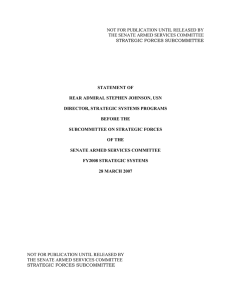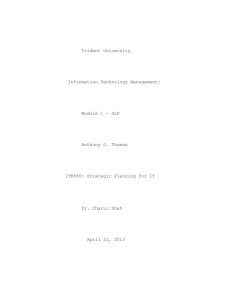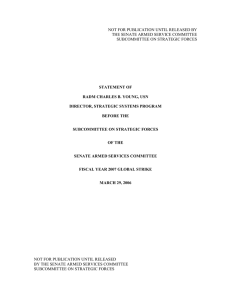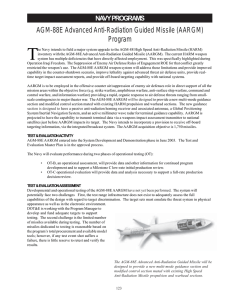NOT FOR PUBLICATION UNTIL RELEASED BY THE SENATE ARMED SERVICES COMMITTEE
advertisement
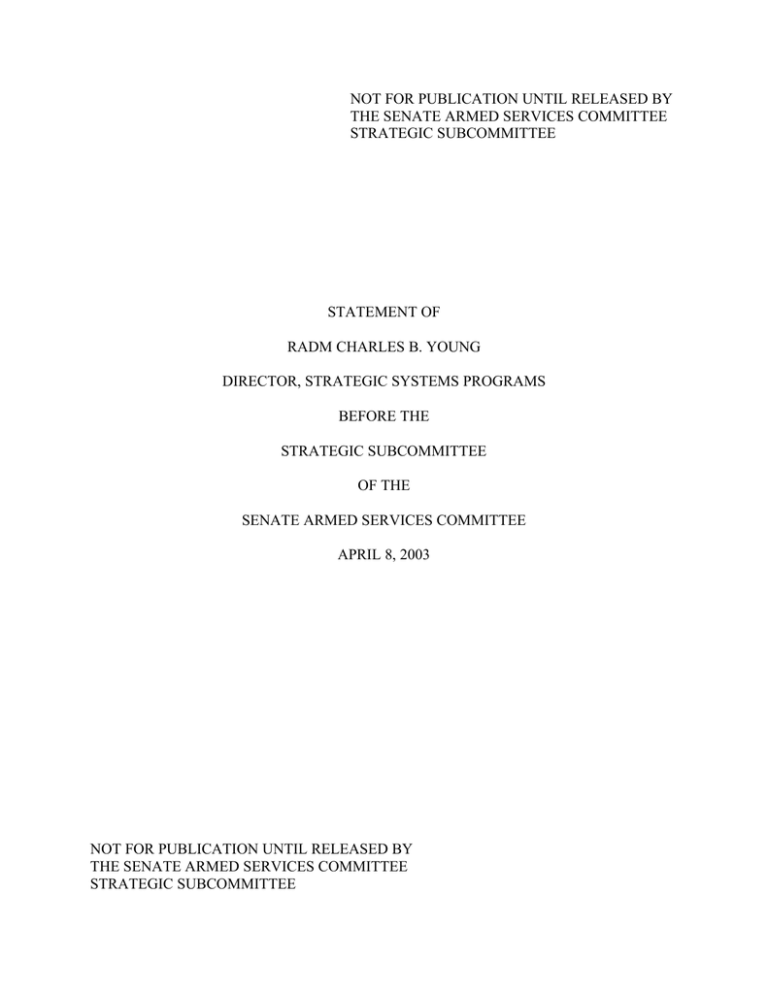
NOT FOR PUBLICATION UNTIL RELEASED BY THE SENATE ARMED SERVICES COMMITTEE STRATEGIC SUBCOMMITTEE STATEMENT OF RADM CHARLES B. YOUNG DIRECTOR, STRATEGIC SYSTEMS PROGRAMS BEFORE THE STRATEGIC SUBCOMMITTEE OF THE SENATE ARMED SERVICES COMMITTEE APRIL 8, 2003 NOT FOR PUBLICATION UNTIL RELEASED BY THE SENATE ARMED SERVICES COMMITTEE STRATEGIC SUBCOMMITTEE Introduction Mr. Chairman, Members of the Committee, I am Rear Admiral Charles B. Young, Director, Strategic Systems Programs. Thank you for inviting me to brief the committee on the status of my programs. Strategic Systems Programs (SSP) is the Program Manager for the TRIDENT I (C4) and TRIDENT II (D5) Strategic Weapon Systems; the Navy’s Executive Agent for all arms control treaties and agreements; the Executive Agent for the US/UK POLARIS Sales Agreement, which was amended to encompass the UK procurement of the TRIDENT II system; and the Navy’s Technical Program Manager for Nuclear Weapons Security. SSP is also responsible for the integration of the Nuclear Powered Guided Missile Submarine (SSGN) Attack Weapons System in the four Nuclear Powered Ballistic Missile Submarines (SSBN) being converted to SSGNs. Before giving you an overview of the TRIDENT II (D5) Acquisition Program, there are several recent significant events and achievements of the program that are noteworthy. In June 2002, the Strategic Weapons Facility, Pacific in Bangor, Washington, achieved Initial Operational Capability (IOC) to support the TRIDENT II Strategic Weapon System in the Pacific. The Navy now has TRIDENT II capability on both coasts. In August 2002, USS NEVADA (SSBN 733) completed her engineered overhaul and backfit conversion to the TRIDENT II Strategic Weapon System at the Puget Sound Naval Shipyard—she was the second ship to complete the TRIDENT II backfit and overhaul ahead of schedule and under budget. In October 2002, USS OHIO (SSBN 726) and USS FLORIDA (SSBN 728) completed their final strategic offloads of TRIDENT I (C4) missiles in preparation for their refueling overhauls and conversions to SSGNs. In December 2002, USS NEVADA successfully launched the 100th TRIDENT II (D5) flight test missile. Finally, in January 2003, USS FLORIDA (SSBN 728) successfully launched two Tomahawk missiles during an SSGN Demonstration and Validation testdemonstrating Tomahawk missiles can be launched vertically from a modified OHIO Class submarine. Overview The TRIDENT II (D5) program achieved Initial Operational Capability (IOC) on 23 March 1990, when the USS TENNESSEE (SSBN 734) was deployed with 24 tactical D5 missiles. The TRIDENT II Strategic Weapon System (SWS) represents the sixth generation of the Navy’s Fleet Ballistic Missile (FBM) Systems, which have served as significant deterrents to aggression and major war since POLARIS (A1) achieved IOC in 1960. The Nuclear Posture Review (NPR), which was forwarded to Congress in December 2001, outlined the Strategic Submarine Force structure: 14 SSBNs outfitted with the TRIDENT II (D5) Strategic Weapon System in 2 oceans. In accordance with the NPR, the remaining four of the original eighteen TRIDENT SSBNs will be converted to SSGNs. To achieve an all D5 SSBN force, backfit of four of the submarines to the D5 Strategic Weapon System from the TRIDENT I (C4) Strategic Weapon System has been initiated. The C4 SWS will be retired in FY 2005. The TRIDENT SWS and support facilities were designed from the beginning to handle the newer and larger missile system with minimal impact and cost. To date, two of the four SSBNs have completed backfit; one is fully operational and making deployments in the Pacific, and the other is finishing its final certification and testing. The second submarine 2 will also be homeported in the Pacific. The last two SSBNs are scheduled to start their backfit in FY 2005 and FY 2006. The contracts have been awarded and much of the required hardware has been procured. The four oldest of the OHIO Class submarines were selected for conversion to SSGNs because of their age and scheduled maintenance periods. As mentioned previously, two of the four submarines have already completed their final strategic offload. The first two SSBN engineered refueling overhauls (EROs) are scheduled to start in FY 2003, followed by conversion to SSGN starting in FY 2004. The third and fourth SSBN EROs are scheduled to start in FY 2004 and FY 2005, respectively, followed by conversion to SSGN starting in FY 2005. Both backfit and SSGN conversion operations are examples of transformational programs that provide an improved capability for the Navy and the nation, extend the life of the submarines beyond their planned life, and represent the return on investment the American people have made in our Navy. The Navy can say with confidence that the Strategic Submarine Force continues to costeffectively provide a survivable, reliable and flexible strategic deterrent. We’ve been aggressively modernizing our deployed Strategic Weapon Systems, shifting to commercial offthe-shelf equipment where practical, developing plans to effectively and economically provide payload flexibility with increased effectiveness against hardened targets, incorporating strategic retargeting capability, and providing hardware and software updates to prevent the obsolescence of our weapon systems. These efforts are a part of the Navy’s strategic vision of Sea Power 21. Program SSP is focused on three primary areas: D5 life extension (D5LE), Nuclear Weapons Security (NWS), and Nuclear Posture Review (NPR) objectives. TRIDENT II (D5) Life Extension The TRIDENT II D-5 life extension (LE) program is required due to the OHIO Class Ballistic Missile Nuclear Submarine (SSBN) service life increasing from 30 years to 45 years. The impact of the SSBN hull life extension is significant in two ways. First, it delays the replacement of these platforms by 15 years, effectively delaying the expenditure of up to $25 billion in current year dollars for follow-on strategic submarine platforms. Second, it requires the service life of the TRIDENT II D-5 Strategic Weapons System (SWS) carried by these ships to also be extended by 15 years. The extended service life requirement affects flight hardware (missile, guidance and reentry) and shipboard hardware (launcher, fire control, navigation and test instrumentation). With respect to flight hardware, D-5 life extension requires procurement of an additional 115 TRIDENT II D-5 missiles, revising the total D-5 procurement objective from 425 to 540. In addition, the guidance system and missile electronics must be replaced due to aging and obsolescence issues. 3 The service life extension for flight hardware requires a strategy that effectively addresses two key issues: (1) supporting the existing systems, recognizing that some parts will fail due to age or become obsolete, and (2) producing the additional flight test missiles required to assure credibility and safety of the deterrent. These flight test missiles support qualification of new or modified components, as well as the additional annual reliability tests required due to extended program life. With the SSBN service life extended to 45 years, a missile inventory shortfall will occur starting in approximately FY 2014 when the oldest OHIO Class submarine would have originally been decommissioned. The 30-year service life procurement objective of 425 TRIDENT II D-5 missiles does not support the additional flight tests necessary to extend the TRIDENT II D-5 SWS to 45 years. The Navy is currently executing a low rate production continuity procurement strategy for critical components of TRIDENT II D-5 missiles. Several missile components are designated as critical, the most important being the rocket motor sets. These critical components are being procured at their minimum rate in advance of when they would be required for full missile assembly to sustain component quality and maintain the supplier base. The production continuity procurement strategy has been extensively reviewed and approved by the Department of Defense (DoD) and the Congress and has been in execution for nearly 15 years. This procurement strategy has proven successful, based on the demonstrated superb performance of the TRIDENT II D-5 Strategic Weapon System. The FY 2004 TRIDENT II WPN budget request includes the continued production of rocket motors and other critical components. The current program fully funds the additional 115 TRIDENT II D-5 LE missiles in FY 2008 through FY 2013, supporting lead-time away from need requirements. Rocket motor sets and other critical components in support of the 115 missile requirement are currently being procured as described above. Rocket motor procurements in support of the additional missiles for life extension began in FY 2002. The current TRIDENT II D-5 Mk-6 Guidance System improved accuracy by a factor of four over the previous TRIDENT I C-4 Mk-5 Guidance Subsystem. As successful and reliable as the Mk6 Guidance Subsystem has been to date, there are significant technology limitations that make this design impractical to maintain throughout the extended life period. The Mk-6 design is based on early 1980’s technology. Production ended with the FY 2001 procurement. Restarting production would be cost prohibitive, and attempting to integrate today’s electronics technology into a 20-year old design would be inefficient and high risk. The Mk-6 guidance subsystem, in its current form, will not support the life extension requirements. The Navy program includes the most affordable and lowest risk approach to meet TRIDENT II D-5 LE requirements by the pursuit of a system to replace the Mk-6, designated the Next Generation Guidance (NGG). Due to the advancements made in technology, both in components (solid state sensors and electronics) and in modeling and simulation, stringent cost targets have been established for NGG with the requirement to meet current Mk-6 performance. The ability to develop precision instruments, sensors, and radiation hardened architectures for NGG requires investment in underlying commercially supported technologies to adapt them for the unique strategic requirements. The redesign approach leverages off of current Air Force/Navy cooperative strategic-unique technology efforts and will result in a Navy TRIDENT II D-5 LE 4 solution and government owned design package that can be used by other Services to leverage off the Navy investment. Similarly, missile electronics packages must also be redesigned for the same aging and obsolescence issues described above for guidance. The technology used for D-5 electronics is obsolete and for most components there is no longer an industrial base. Thus, the TRIDENT II D-5 electronics subsystem will require new package designs for the additional missile procurements and for backfit into existing missiles, since legacy electronic components are no longer available. The Navy’s FY 2004 WPN request continues the missile electronics and guidance system redesign efforts begun in FY 2003. The D5 missile is capable of carrying both the W76/MK4 and the W88/MK5 reentry bodies. While the W88/MK5 was designed specifically for the D5 during the early 1980s and will not need to be immediately refurbished, the W76/MK4 warhead and fuze carried on the MK4 reentry body was designed in the early 1970s and began deployment in 1979 on the TRIDENT I (C4) missile with a design life of 20 years. The W76/MK4 program was based on the older W68/MK3 design and some of the components were carried over from that program. There are technical and programmatic issues that require both a refurbished warhead and a refurbished fuze for the W76/MK4. The Department of Energy and the Navy are executing a refurbishment program for the W76/MK4 reentry body. The Navy’s refurbishment of the W76/MK4 fuze is supported in the Navy’s FY 2004 WPN budget request. With respect to shipboard hardware, life extension is taking place on a somewhat continuous "refreshment" basis, with the computing and electronic component parts of these systems moving rapidly towards the integration of commercial off-the-shelf (COTS) products. Because of the low cost of COTS hardware components, it is more cost-effective to adopt a shorter refresh cycle than possible with previous generations of custom hardware/software. This strategy reduces support costs while maintaining high reliability and safety. All shipboard SWS Subsystems have life extension programs planned or in place to support the SSBN 45 year life. In addition to the COTS components, there is specialized equipment required to support the mission, such as the highly precise strategic submarine inertial navigation equipment. Prudent investment in these equipments is also contained in the Navy’s FY 2004 OPN request. The goal for each subsystem will be to mitigate known obsolescence and supportability problems, providing both cost avoidance and reduced life cycle costs. The Navy’s FY 2004 OPN budget request supports these shipboard subsystem life extension efforts. TRIDENT II (D5) life extension efforts ensure a credible, survivable and affordable strategic deterrent capability well into the 21st century. Nuclear Weapons Security The Navy continues to meet all current DoD policy regarding Nuclear Weapons Security. There was a significant investment during the design and construction of both Strategic Weapons Facilities in Bangor, Washington and Kings Bay, Georgia primarily in the weapons storage areas (WSA) and the assignment of sizable dedicated security forces to protect nuclear weapons within the WSA. However, the attack on the USS COLE and the events of 9/11 caused the DoD and 5 Navy to re-evaluate the security posture of all our nuclear weapon storage facilities around the globe from all three axes of threatland, sea and air. In regard to Nuclear Weapons Security, the Navy has determined a security posture similar to what is currently established in the WSA should be extended to the waterfront and during transit to and from the dive point at which point the submarine can submerge and protect itself. Therefore, we have initiated an integrated Nuclear Weapons Security program. This program will provide a layered defense under a command structure with centralized command, control, communication, monitoring and surveillance. Utilizing a balanced mixture of technology and manpower, the Navy will have the capability to ensure this security posture is sustainable over the long term. This integrated program will be implemented, provided resources are available, in a phased approach with initial investments beginning in FY 2003, and taking approximately six years to reach full operational capability. The lengthy implementation time is driven primarily by the lead-time for military construction project design, construction and outfitting. Interim measures are being undertaken to mitigate risk with initial investments focused on our highest vulnerability areas. Nuclear Posture Review (NPR) Objectives Research and Development (RDT&E,N) The most significant change in the Navy strategic programs budget is in research and development. SSP’s RDT&E,N budget increases from about $34 million in FY 2003 to about $102 million in FY 2004. This arises from the need to enable the dramatic changes articulated in the new Strategic Framework outlined by the December 2001 Nuclear Posture Review (NPR). The inherent flexibility in warhead loading of the TRIDENT submarine launched ballistic missile force enables the Department of Defense to execute the reduction of deployed nuclear warheads to achieve the Moscow Treaty and congruent NPR objectives in force structure. The NPR goes beyond a mere changing of force levels to describe the changes in the framework for, and nature of the Nation’s strategic forces needed in the future. Navy efforts in contributing a Sea Shield element of missile defense are implemented in other programs, while the TRIDENT program makes significant Sea Strike contributions to the offensive and infrastructure legs of the new Triad described in the NPR. These contributions are achieved by “Applications” programs in specific technology areas and in focused development programs for specific capabilities. Applications programs develop and evaluate new technologies for potential use in existing and future strategic systems. The strategic guidance and reentry body applications programs have existed for about eight years. This effort is increased in FY 2004. New applications programs in strategic propulsion and radiation hardened electronics are contained in the FY 2004 budget. Separate from the applications programs, a specific technology solution, Enhanced Effectiveness (E2), has been identified and included in the FY 2004 budget. E2 is a technology development effort fully supported by the Commander, US Strategic Command, for achieving improved missile accuracy. It aims at enhancing the accuracy of an existing weapon system, the W76/ MK4 reentry body used on the TRIDENT submarine-launched ballistic missile (SLBM). Applications programs have the major goal of sustaining unique strategic technology, design talents and infrastructure needed by the Nation to maintain dominant strategic forces. In essence, these applications programs are the Nation’s “seed corn” in strategic offensive missile systems. This is needed to both develop future replacement systems and to fix any performance issues 6 within existing systems. Since the Navy and Air Force have a common need for this talent in strategic missile (ICBM and SLBM) technologies, the Department of Defense has a strategy of executing coordinated, complementary programs in each service. The Navy and Air Force carefully coordinate technology areas and critical skills to obtain maximum synergy in meeting the Nation’s need in this critical area. The Navy has four major applications program efforts included in the FY 2004 budget request: Reentry System Applications Program (RSAP), Strategic Guidance Applications Program (GAP), Strategic Propulsion Applications Program (SPAP), and Radiation Hardened Applications Program (RHAP). Each of these is briefly described. Reentry Systems Applications Program (RASP). Unique strategic reentry environments require technologies in materials needed to provide long service life while being able to survive the extreme atmospheric reentry and possible radiation environment. Critical and unique attributes necessary for the design, development and testing of ICBM and SLBM reentry systems have been defined and will be maintained. Critical technologies are heat shield and nose-tip material and fuze electronics. Navy requirements have been integrated with Air Force requirements into a comprehensive program that maintains close coordination with the DoD Science and Technology (S&T) community to leverage S&T programs and avoid unintended duplication of effort. To ensure these efforts are focused on real solutions, RSAP demonstrates appropriate emerging technologies through actual reentry flight test evaluations. Strategic Guidance Applications Program (GAP). Unique strategic guidance requires technologies that provide extreme accuracy over long ranges while potentially operating in a hostile radiation environment. The GAP program provides a strategic guidance core technology development capability consistent with the Strategic Advisory Group (SAG) recommendation to COMSTRATCOM. System accuracy and functionality depends upon key technologies, which provide radiation hardened accelerometer, gyroscopes and stellar sensing capabilities. A critical skill is the ability to integrate these elements together in a extremely high performing and reliable system. As the underlying technologies that currently provide these capabilities age and are no longer technically supportable, modern alternatives must be made available to allow for orderly replacement. There is no commercial market for these technologies and their viability depends on the strategic community. The RSAP and GAP programs have increased their combined funding of $34 million in FY 2003 to $44 million in FY 2004 to better meet these unique strategic needs. Strategic Propulsion Applications Program (SPAP). Strategic propulsion requires technologies to provide large high performance solid rocket motor systems that have a long shelf life, high reliability and safe handling and storage. The SPAP program, commencing in FY 2004, will be a coordinated Navy and Air Force effort to exercise these unique design talents and infrastructure needs. Key elements of SPAP are investment in propellant technologies, nozzle and case materials and integrating these into an effective solution. Boost propulsion (missile stages), post boost propulsion (missile payload delivery vehicle) and ordnance (separation events and flight termination events) are all integral parts of missile propulsion application efforts. 7 To focus on developing real system solutions, an annual large-scale rocket motor test firing of developed technology is planned. A sound base of demonstrated technologies suitable for Strategic Missile applications will be maintained and will provide the nation a talent base and source of technologies suitable for current and follow-on development programs. The Navy SPAP program starts at $8 million in FY 2004 and increases in future years. Radiation Hardened Applications Program (RHAP). Radiation hardening electronics for potential strategic radiation environment results in technology challenges as well as industrial base issues. The Radiation Hardened Oversight Council (RHOC), chaired by the Director, Defense Research & Engineering (DDR&E), coordinates these efforts. The RHAP program will focus on a coordinated productization & qualification effort, which provides a transition between on-going Science and Technology (S&T) efforts and production for actual use. The RHOC has developed a technology road map that coordinates these efforts into the Department of Defense investment strategy. In addition, the RHAP will sustain critical skills in radiation hardened electronics design and simulation techniques to support the ability to design radiation hardened strategic missile, guidance and reentry systems. These efforts become of greater importance because of the shrinking industrial base for radiation hardened electronics, the fast-moving commercial electronics market, the unavailability of underground testing resources and the loss of radiation hardened expertise. The RHAP will compliment RSAP and GAP efforts by specifically focusing on those tasks required to ensure producibility of radiation hardened parts. The FY 2004 budget requests $20 million for the radiation hardened applications program. Enhanced Effectiveness Program (E2). Enhanced Effectiveness provides increased capabilities articulated in the NPR, such as prompt accurate strike, defeat of critical targets and selective nuclear options. This program is a three-year effort culminating in a flight test demonstration of a TRIDENT reentry body with dramatically improved accuracy. The approach is to integrate existing technologies into a reentry body extension. The extension would attach to the existing W76/MK4 warhead, giving it the size and weight of the larger W88/MK5 warhead. Since the current D5 missile is capable of carrying either the MK4 or MK5 warhead, the changes to the missile are minimal. The FY 2004 budget contains about $30 million for the Enhanced Effectiveness effort. The E2 program is an R&D effort; it includes no funding for procurement. Any procurement program that employs this technology will be presented to Congress for authorization in future budget requests. SSGN Strategic Systems Programs is playing a major role in support of one of the Navy’s initiatives in Sea Power 21. The SSBN-to-SSGN conversion will provide a near-term transformational capability to the Nation, removing four OHIO Class submarines from strategic service, refueling their reactors to permit an additional 20 years of operation, and converting them into conventional strike platforms. Strategic Systems Programs, in support of the SSGN program manager, is providing the Attack Weapons System for the SSGNs. As part of the development of that system, a demonstration 8 and validation was conducted in January. USS FLORIDA (SSBN 728), an OHIO Class submarine, successfully launched two Tomahawk cruise missiles, confirming the ability to launch a Tomahawk from a configuration similar to the tightly packed cluster of Tomahawk AllUp-Rounds (AUR) we will use in the SSGN. In addition to this demonstration and validation supporting the multiple all-up-round canister development and design, the firings supported the Navy’s Sea Trial experiment, Giant Shadow, which also explored how a network of forces, including special warfare forces, and various unmanned aerial, underwater and ground vehicles and sensors could be used to provide surveillance, collect real-time intelligence, and develop and launch a time critical strike in support of the joint force commander. This included the first vertical launch of a unmanned underwater vehicle (UUV), testing of nuclear-biological-chemical sensors, and the insertion of Navy SEALs from one of the submarines the Navy will convert to an SSGN. For the Attack Weapons System for SSGN, Strategic Systems Programs is leveraging existing strategic weapons systems technology and expertise including the use of commercial off-theshelf technology in shipboard systems to minimize the life cycle cost. The FY 2004 budget request supports the continued design, development and procurement of the Attack Weapons System. Our future SSGN forces will provide large volume clandestine strike with cruise missiles and the capability to support and insert Special Operations Forces. The flexibility provided by missile tube volume supports payload adaptability to meet emerging mission requirements. The Navy will leverage the existing TRIDENT submarine infrastructure to optimize their onstation time. The first two ships, the USS OHIO and USS FLORIDA, enter the shipyard in FY 2003 to begin their engineered refueling overhauls (EROs) and conversions. USS MICHIGAN and USS GEORGIA will begin their EROs and conversions in FY 2004 and FY 2005, respectively. We expect the first SSGN to be operational in FY 2007. Summary In summary, I am pleased to report the TRIDENT II (D5) Strategic Weapon System continues to meet or exceed all design objectives. The FY 2004 President’s Budget supports the NPRdirected force structure requirement of 14 D5 SSBNs; fully funds D5 Life Extension requirements; provides funding to ensure an integrated approach to Nuclear Weapons Security; includes R&D investments and funding for SSGN conversion that meets the NPR objectives. In spite of significant challenges, I reiterate with confidence that the Navy’s Strategic Submarine Force continues to cost-effectively provide a survivable, reliable, and flexible strategic deterrent. Thank you. 9
